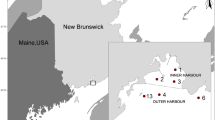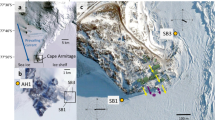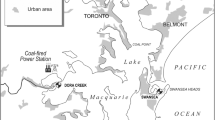Abstract
A field-based evaluation of the biological effects of potential nickel (Ni) exposures was conducted using monitoring data for benthic macroinvertebrates and water chemistry parameters for streams in England and Wales. Observed benthic community metrics were compared to expected community metrics under reference conditions using RIVPACS III+ software. In order to evaluate relationships between Ni concentrations and benthic community metrics, bioavailable Ni concentrations were also calculated for each site. A limiting effect from Ni on the 90th percentile of the maximum achievable ecological quality was derived at “bioavailable Ni” exposures of 10.3 μg l−1. As snails have been identified as particularly sensitive to nickel exposure, snail abundance in the field in response to nickel exposure, relative to reference conditions, was also analysed. A “low effects” threshold for snail abundance based on an average of spring and autumn data was derived as 3.9 μg l−1 bioavailable Ni. There was no apparent effect of Ni exposure on the abundance of Ephemeroptera (mayflies), Plecoptera (stoneflies) or Tricoptera (caddisflies) when expressed relative to a reference condition within the range of “bioavailable Ni” exposures observed within the dataset. Nickel exposure concentrations co-vary with the concentrations of other stressors in the dataset, and high concentrations of Ni are also associated with elevated concentrations of other contaminants.








Similar content being viewed by others
References
Biological Monitoring Working Party (1978) Final report: assessment and presentation of the quality of rivers in Great Britain. Report, Department of the Environment, Water Unit
Brix K, Esbaugh A, Munley K, Grosell M (2012) Investigations into the mechanism of lead toxicity to the freshwater pulmonate snail, Lymnaea stagnalis. Aquat Toxicol 106–107:147–156
Cade B, Noon B (2003) A gentle introduction to quantile regression for ecologists. Front Ecol Environ 1:412–420
Cade B, Terrel J, Schroeder R (1999) Estimating effects of limiting factors with regression quantiles. Ecology 80:311–323
Carlisle D, Clements W (1999) Sensitivity and variability of metrics used in biological assessments of running waters. Environ Toxicol Chem 18:285–291
Clarke RT, Wright JF, Furse MT (2003) RIVPACS models for predicting the expected macroinvertebrate fauna and assessing the ecological quality of rivers. Ecol Model 160:219–233
Clements WH, Newman MC (2002) Community ecotoxicology. Wiley, Chichester
R Core Team (2012). R: a language and environment for statistical computing. R Foundation for Statistical Computing, Vienna. ISBN 3-900051-07-0, URL http://www.R-project.org/
Crane M, Kwok KWH, Wells C, Whitehouse P, Lui GCS (2007) Use of field data to support European Water Framework Directive quality standards for dissolved metals. Environ Sci Technol 41:5014–5021
De Schamphelaere KAC, Van Laer L, Deleebeeck NME, Muyssen BTA, Degryse F, Smolders E, Janssen CR (2006) Nickel speciation and ecotoxicity in European natural surface waters: development, refinement and validation of bioavailability models. Report prepared for the Nickel Producers Environmental Research Association (NiPERA), Durham, NC, USA. Laboratory of Environmental Toxicology and Aquatic Ecology, Gent University, Gent
Deleebeeck NME, De Schamphelaere KAC, Janssen CR (2007) A bioavailability model predicting the toxicity of nickel to rainbow trout (Oncorhynchus mykiss) and fathead minnow (Pimephales promelas) in synthetic and natural waters. Ecotoxicol Environ Saf 67:1–13
Deleebeeck NME, De Schamphelaere KAC, Janssen CR (2008) A novel method for predicting chronic nickel bioavailability and toxicity to Daphnia magna in artificial and natural waters. Environ Toxicol Chem 27:2097–2107
Deleebeeck NME, De Schamphelaere KAC, Janssen CR (2009) Effects of Mg2+ and H+ on the toxicity of Ni2+ to the unicellular green alga Pseudokirchneriella subcapitata: model development and validation with surface waters. Sci Total Environ 407:1901–1914
DEPA (2010) Nickel and its compounds (final revision Oct 12 2010) WFD EQS proposal. Danish Environment Protection Agency, Copenhagen
Environment Agency (1997) Distribution of macroinvertebrates in English and Welsh rivers based on 1995 survey. R&D technical report E12. Environment Agency of England and Wales, Bristol
Environment Agency (1999) Procedure for collecting and analysing macroinvertebrate samples BT001 (Version 2.0). Environment Agency of England and Wales, Bristol
Environment Agency (2008) Environmental quality standards for trace metals in the aquatic environment. SC030194. Environment Agency, Bristol
European Union (2008) Directive 2008/105/EC of the European Parliament and of the council of 16 December 2008 on environmental quality standards in the field of water policy, amending and subsequently repealing council directives 81/176/EEC, 83/513/EEC, 84/156/EEC, 84/491/EEC, 86/280/EEC and amending Directive 2000/60/EC of the European Parliament and the Council. Official Journal of the European Union. L 348/84
European Commission (2012) Proposal for a directive of the European Parliament and of the council amending directives 2000/60/EC and 2008/105/EC as regards priority substances in the field of water policy. COM (2011) 876 final. European Commission, Brussels
Heijerick D, Vercaigne I (2011) Ni-BLM sensitivity analysis for different ecoregions. Draft report to NiPERA, January 2011. NiPERA, Durham
Linton TK, Pacheco MAW, McIntyre DO, Clement WH, Goodrich-Mahoney J (2007) Development of bioassessment based benchmarks for iron. Environ Toxicol Chem 26:1291–1298
Murray-Bligh JAD, Furse MT, Jones FH, Gunn RJM, Dines RA, Wright JF (1997) Procedure for collecting and analysing macroinvertebrate samples for RIVPACS. Environment Agency and Institute for Freshwater. Ecology, Bristol
Pacheco M, McIntyre D, Linton T (2005) Integrating chemical and biological criteria. Environ Toxicol Chem 24:2983–2991
Peters A, Crane M, Adams W (2011) Effects of iron on benthic macroinvertebrate communities in the field. Bull Environ Contam Toxicol 86:591–595
Scharf F, Juanes F, Sutherland M (1998) Inferring ecological relationships from the edges of scatter diagrams: comparison of regression techniques. Ecology 79:448–460
Schlekat C, Van Genderen E, De Schamphelaere K, Antunnes P, Rogevich E, Stubblefield W (2010) Cross species extrapolation of chronic nickel biotic ligand models. Sci Tot Env 408:6148–6157
UKTAG (2006) Development of environmental standards for rivers, biochemical oxygen demand, dissolved oxygen, ammonia. UK Technical Advisory Group Rivers Task Team technical report
Wright JF (2000) An introduction to RIVPACS. In: Wright JF, Sutcliffe DW, Furse MT (eds) Assessing the biological quality of freshwaters: RIVPACS and similar techniques. Freshwater Biological Association, Cumbria, pp 1–24
Acknowledgments
This work was funded by the Nickel Producers Environmental Research Institute. The authors are also grateful for the provision of data by the Environment Agency for England and Wales. We thank two anonymous referees for their helpful comments on the first draft of the paper.
Author information
Authors and Affiliations
Corresponding author
Additional information
Responsible editor: Philippe Garrigues
Rights and permissions
About this article
Cite this article
Peters, A., Simpson, P., Merrington, G. et al. Assessment of the effects of nickel on benthic macroinvertebrates in the field. Environ Sci Pollut Res 21, 193–204 (2014). https://doi.org/10.1007/s11356-013-1851-2
Received:
Accepted:
Published:
Issue Date:
DOI: https://doi.org/10.1007/s11356-013-1851-2




